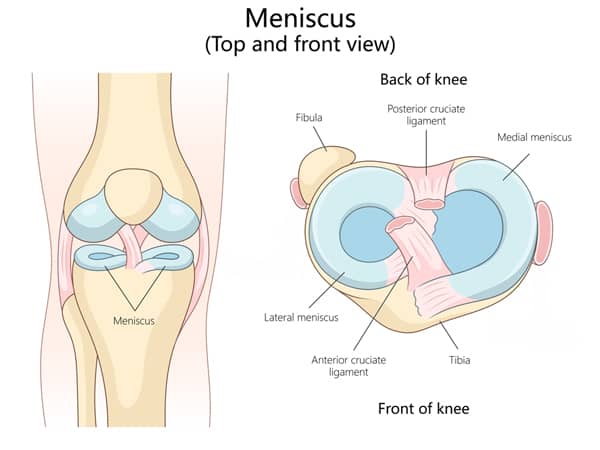Who Needs a Meniscus?
The science surrounding the role of the meniscus cartilage in knee joint health evolves daily. Its key role in absorbing the forces of walking and running is now understood to be only a part of the meniscus story. Here is the current picture:

Pictured: Avid skier and meniscus transplant patient Mark M. prepping for another season of 100 days of downhill skiing.
The structure of the meniscus is an array of collagen fibers tied together with radial rods of stiffer collagen. Unique meniscus cells and stem cells are interspersed within the tissue. Small blood vessels and nerves provide nutrition and sensation. The meniscus attaches primarily to the tibia through ligaments in the center of its C-shaped tissue and into bone at the horns. With this complex structure, the meniscus absorbs forces and provides stability to the knee joint.

Children need this tissue while they are growing as, early on, the shape of the tissue and joints are interactively influenced. In normal development, two menisci form in the knee joint in the classic C-shape. Sometimes the tissue forms into a disc or discoid shape that covers the tibial surface. The collagen fibers in discoid menisci are abnormal in this orientation and sometimes fail later in life.
Athletes of all ages need their meniscus. People normally take 2-3 million steps per year, loading their knees with up to five times their body weight depending on the height of the step, the surface landed on, the shoe’s quality and condition, and the mechanics of walking or running. Optimized gaits, such as Chi running, produce fewer peak forces on the joint, but being over your optimal weight by as little as 10 pounds can produce up to 50 lbs. of excess force on the joint. If a small amount of the meniscus is missing in critical areas (such as the back 25% of the meniscus), the forces of weight bearing are not distributed normally and are concentrated in a smaller area on the tibial surface. Over millions of steps per year, these additional forces wear off the articular cartilage surface, leading to arthritis. Impact sports such as running, jumping, volleyball, basketball, and many others are fine for healthy knees—but if through injury, the meniscus is lost or torn, the knee joint degrades.
People who lose their meniscus during surgery, where a tear is resected, may benefit from an early meniscus replacement before they develop pain and arthritis. It is difficult to know how much of a meniscus resection should call for an “urgent” need for meniscus replacement, but since so many people go on to develop arthritis after partial meniscectomy, the need is vastly underestimated.
People with arthritis need their meniscus. Post-traumatic arthritis and osteoarthritis are characterized by loss of the bearing surface of the joints, the articular cartilage, and by bone and tissue changes. It was previously thought that once arthritis developed in a knee joint that had lost part or all of its meniscus, nothing other than an artificial joint could solve the problem. Yet for many people, replacing the meniscus and treating the arthritis with repair techniques can lead to pain relief and a renewed active lifestyle. Stone Research Foundation just published a peer-reviewed paper on people over 50 years of age who, referred for partial or total knee joint replacement due to arthritis, instead had a new meniscus implanted and their cartilage repaired with our paste graft technique. In a long-term study lasting up to 25 years, 42% of patients experienced an average of eight years of relief before needing a partial or total knee replacement, while 48% never needed a replacement at all1.
The surgery for meniscus replacement is difficult as the tissues are not widely available, the insurance is often confusing, and the number of surgeons experienced in the procedure is limited. However, the science and techniques are rapidly improving. My first presentation on this topic was in 1986, when my closing slide stated “Save the Meniscus.” This has never been more true.
Citation
- Stone, K. R., Walgenbach, A. W., Slatter, S., Turek, T. J., Ferguson-Dryden, C., Dicker, M., Miltenberger, E., Cowles, H., Liu, V., Wu, S., & Vessal, M. (2024). Meniscus allograft transplantation in conjunction with arthroscopic biologic knee restoration delays arthroplasty in patients older than 50 years. Arthroscopy. Advanced online publication. https://www.sciencedirect.com/science/article/pii/S0749806324004183?dgcid=author


